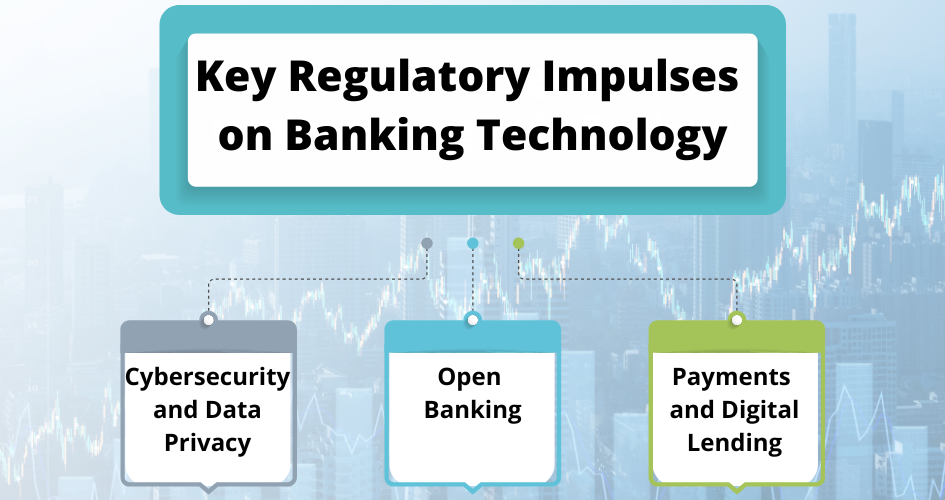
Navigating the Crossroads: How Regulatory Changes Shape Banking Technology in India
India’s banking landscape is undergoing a transformative shift. Driven by a surge in digital adoption and a burgeoning ecosystem, technology plays an increasingly crucial role in shaping the industry’s future. However, this dynamic space is also subject to ever-evolving regulatory changes, presenting challenges and opportunities for banks and technology providers.
The Regulatory Landscape: Fostering Innovation and Stability
The Reserve Bank of India (RBI) has embraced a proactive approach to regulating banking technology. Initiatives like the “Regulatory Sandbox” have created a safe space for startups to experiment and innovate, fostering a vibrant ecosystem. The Reserve Bank of India (RBI) has actively promoted emerging technologies such as blockchain and artificial intelligence (AI). While simultaneously implementing regulations to mitigate associated risks.
However, the regulatory landscape remains complex, with new guidelines and directives constantly evolving. This can pose significant challenges for banks, requiring them to invest in compliance infrastructure and continuously adapt their technology strategies.

Key Regulatory Impulses on Banking Technology
Several key regulatory changes have had a significant impact on the adoption and development of banking technology in India:
Cybersecurity and Data Privacy: Robust cybersecurity measures and stringent data privacy practices, as emphasized by regulations like the Information Technology Act (2000) and the Data Protection Bill (2022), have led banks to invest heavily in secure technologies and implement data governance frameworks.
Open Banking: The RBI’s Open Banking framework enables third-party players to access customer data with their consent, allowing for innovative financial products and services. This is driving the development of APIs and data analytics capabilities within banks.
Payments and Digital Lending: Regulations like the Payment and Settlement Systems Act (2007) and the Payment Banks Guidelines (2016) have facilitated the emergence of digital payment solutions and innovative lending platforms. This has spurred the adoption of cloud computing, machine learning, and other payment processing and risk assessment technologies.
Impact of Regulations: A Balancing Act
While regulations promote stability and consumer protection, their impact on banking technology can be multifaceted. Regulations can act as catalysts for innovation by creating a level playing field and encouraging banks to explore new technologies to meet compliance requirements. Implementing and maintaining compliance infrastructure can be expensive for banks, particularly smaller institutions. This can deter some banks from adopting innovative technologies. Overly restrictive regulations can stifle innovation by creating unnecessary hurdles for startups and hindering their ability to experiment and scale.
The Way Forward: Striking the Right Balance
To successfully navigate the constantly changing financial landscape, banks and regulators must collaborate effectively. Banks must adopt agile and adaptable technologies that accommodate evolving regulatory frameworks. Implementing robust risk management frameworks and leveraging technology solutions for data security and fraud prevention is paramount.
Clear and predictable regulatory guidelines are essential for facilitating long-term investments in banking technology. Fostering a collaborative environment between banks, regulators, and startups can accelerate innovation and enable the responsible development of new technologies.
Beyond the Key Changes: A Deeper Dive into Regulatory Impacts
In addition to the key regulations mentioned earlier, several other regulatory changes have significant impacts on specific aspects of banking technology in India. Regulations like the Pradhan Mantri Jan Dhan Yojana (PMJDY) have spurred the adoption of mobile banking and digital wallets to provide financial access to unbanked populations. It has led to an increased focus on developing user-friendly and vernacular-enabled technology solutions.
The Prevention of Money Laundering Act (2002) and KYC guidelines require banks to implement robust customer identification and transaction monitoring systems. It has driven the adoption of AI and machine learning-based solutions for automated onboarding, fraud detection, and risk assessment.
The RBI’s proposed Central Bank Digital Currency (CBDC) – the Digital Rupee – can potentially revolutionize the country’s financial landscape. It necessitates significant infrastructure upgrades and the development of secure and interoperable technologies for issuing, distributing, and managing digital currency.
Challenges and Opportunities: A Multifaceted Perspective
The impact of regulatory changes extends beyond banks, impacting different stakeholders within the ecosystem. Navigating complex regulations can be challenging for smaller startups, hindering their ability to compete with established players. Regulatory sandboxes and innovation-friendly frameworks are crucial to support their growth and foster a thriving ecosystem. Regulations play a vital role in protecting consumer rights and data privacy.
However, overly restrictive regulations can limit consumer access to innovative financial products and services. Finding the right balance between ensuring consumer protection and fostering financial inclusion is key. Regulatory changes present both challenges and opportunities for technology providers. They need to be agile and adaptable to develop solutions that comply with evolving regulations while meeting the specific needs of banks and players.
Shaping the Future: The Path Forward
India needs several key initiatives to ensure sustainable and responsible development of banking technology. Expanding the scope of the regulatory sandbox to include more startups and emerging technologies can accelerate innovation and encourage responsible experimentation. Establishing standardized APIs across the banking sector will facilitate seamless data exchange and interoperability between banks and financial institutions. Leveraging technology solutions can streamline compliance processes and reduce the burden on banks. Educating consumers about their rights and responsibilities in the digital age is crucial to building trust and promoting responsible digital financial practices. Sharing best practices and collaborating with other countries on regulatory frameworks can foster global interoperability and ensure a level playing field for businesses.
Conclusion: A New Era of Banking Beckons
The intersection of regulatory changes and technological advancements presents challenges and opportunities for the Indian banking sector. By fostering a collaborative environment, embracing innovation, and prioritizing consumer protection, India can harness the power of technology to create a more inclusive, efficient, and secure financial system for all. As technology continues to evolve at an unprecedented pace, the future of banking in India is poised for transformative change, paving the way for a new era of financial services that cater to the evolving needs of a dynamic and digitally connected population.
How Can Datavision help?
We assist various financial institutions and global banks on their digital transformation journey. Our one-of-a-kind approach, which combines people, process, and technology, expedites the delivery of superior results to our clients and drives excellence. Several reputed companies leverage our proprietary suite of business excellence tools and services to unlock new growth levers and unparalleled ROI.
Datavision stands proudly as a prominent banking software solutions provider, recognized for our unwavering commitment to excellence in the industry. We have earned our esteemed reputation by consistently delivering cutting-edge core banking software, catering to the needs of both retail and corporate banking software sectors. At Datavision, our mission is clear: to provide our clients with the best banking software products, ensuring that they stay ahead in an ever-evolving financial landscape. We take pride in serving our prestigious clients and look forward to continuing our journey of innovation and excellence.
Our portfolio of banking software product and services include:
Core Banking Solutions: | FinNext Core | Banking: | FinTrade | EasyLoan | MicroFin |
Digital Banking Solutions: | IBanc | MobiBanc | MBranch | FinTab | FinSight |
Risk & Compliance: |FinTrust |
Want to know how our team of experts at Datavision provides customizable, scalable, and cost-effective banking software products and solutions to our esteemed clients? Visit us for more information.